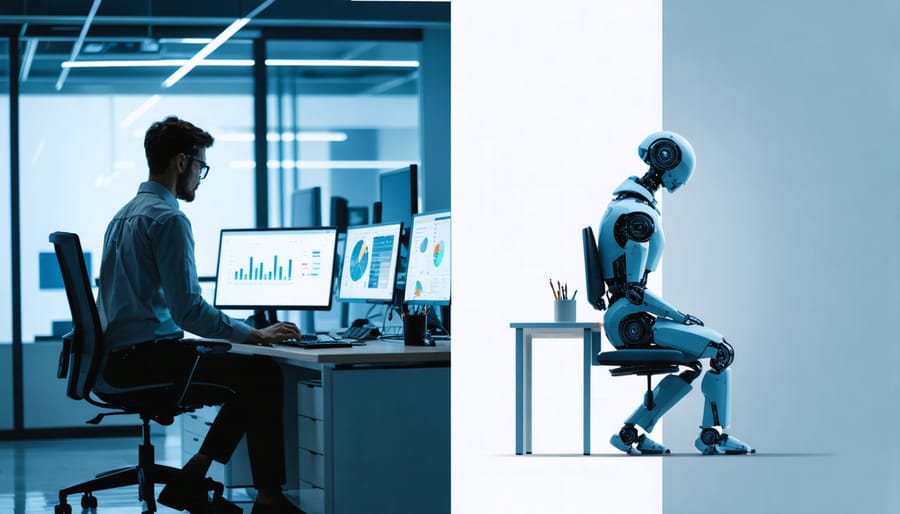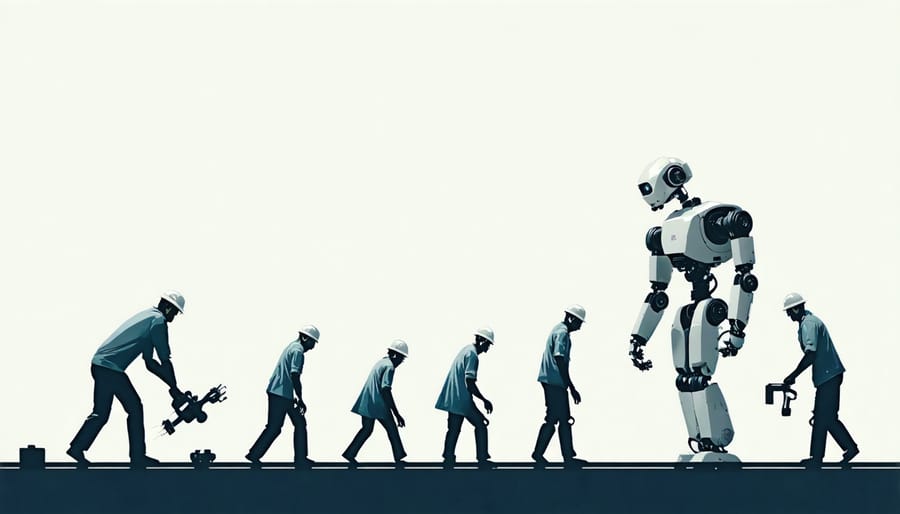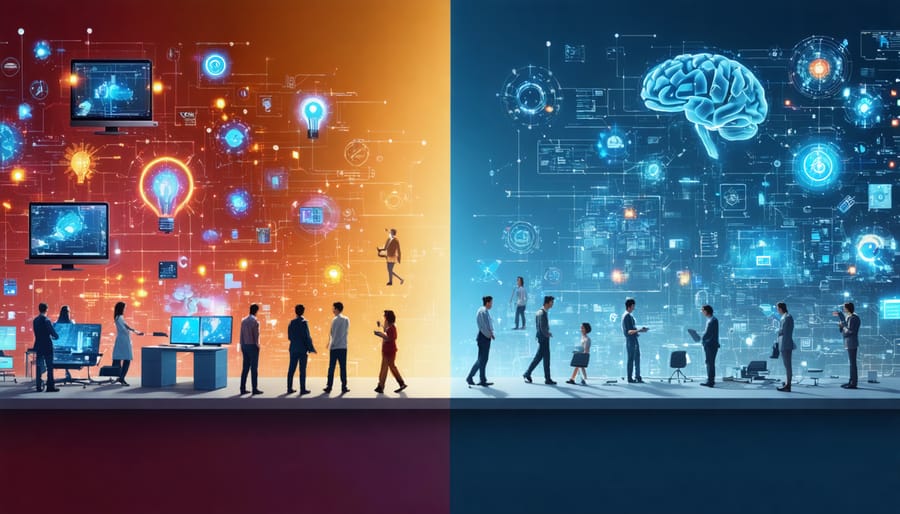Artificial Intelligence isn’t just a technological revolution – it’s rapidly becoming one of the most pressing social challenges of our time. AI’s impact on social inequality reaches far beyond Silicon Valley, touching everything from job markets to healthcare access and educational opportunities. As AI systems become more deeply embedded in our daily lives, they’re creating new social divides while amplifying existing ones.
Consider how AI-powered hiring tools can perpetuate historical biases, or how predictive algorithms in healthcare might favor certain demographic groups over others. These aren’t just technical glitches – they’re societal fault lines that grow wider with each advancement in AI technology. The gap between those who can harness AI’s benefits and those left behind is expanding at an alarming rate.
Yet this technology also holds unprecedented potential for solving social challenges. The key question isn’t whether AI is a social issue – it’s how we can ensure its development serves all of society, not just a privileged few. As we stand at this technological crossroads, our decisions about AI governance and accessibility will shape social equality for generations to come.
The Digital Divide Gets Deeper
Access to AI Tools
The growing digital divide in access to AI tools is creating a new form of social inequality. While artificial intelligence promises to revolutionize education, career development, and personal productivity, these benefits aren’t equally distributed across society. Many advanced AI tools require expensive subscriptions or high-end hardware, putting them out of reach for lower-income individuals and communities.
Consider the example of AI-powered tutoring systems, which can provide personalized learning experiences and help students master complex subjects. However, these tools often come with substantial price tags, meaning students from affluent backgrounds gain additional educational advantages while others fall further behind. Similarly, professionals looking to upskill or transition careers face barriers when AI-powered learning platforms and certification programs require significant financial investment.
The geographic distribution of AI infrastructure also plays a role. Rural areas and developing regions often lack the high-speed internet connections necessary to run sophisticated AI applications effectively. This creates a two-tier system where urban centers with robust digital infrastructure pull ahead while other areas struggle to keep pace with technological advancement.
Even when free or low-cost AI tools are available, many people lack the digital literacy skills needed to utilize them effectively. This creates a compound effect where those already familiar with technology can quickly adapt to new AI tools, while others face a steeper learning curve and risk being left behind in an increasingly AI-driven world.

The Skills Gap Widens
As AI technology becomes increasingly integrated into the workplace, a concerning trend is emerging: the widening skills gap between those who can effectively work with AI systems and those who cannot. This division is creating a new form of digital inequality that goes beyond simple computer literacy.
Today’s job market increasingly demands AI-related skills, from basic understanding of machine learning concepts to hands-on experience with AI tools. Companies are rapidly adopting AI solutions for everything from customer service to data analysis, making these skills essential for career advancement. However, access to AI education and training remains unevenly distributed.
The disparity is particularly evident in education systems worldwide. While some schools and universities offer comprehensive AI and programming courses, many institutions, especially in underserved communities, lack the resources to provide such training. This educational gap translates directly into employment opportunities, with AI-skilled workers commanding higher salaries and better job prospects.
The economic implications are significant. As automation increases, workers without AI-relevant skills face potential displacement, while those with AI expertise become increasingly valuable. This creates a self-reinforcing cycle where those who already have access to AI education and training opportunities continue to advance, while others fall further behind.
Organizations and governments must address this growing divide through targeted education programs, workforce development initiatives, and policies that ensure equal access to AI training opportunities. Without intervention, the AI skills gap threatens to exacerbate existing social and economic inequalities.
AI in the Workplace: Winners and Losers

Job Displacement Patterns
The impact of AI automation in the workplace isn’t affecting all communities equally. Studies show that certain demographic groups face a higher risk of job displacement due to AI technologies. Workers in routine-based occupations, such as manufacturing, data entry, and customer service, are particularly vulnerable to automation.
Lower-income communities and workers without advanced degrees often experience the most significant disruption. These groups typically hold positions that involve repetitive tasks, which AI systems can increasingly perform. For example, retail cashiers, assembly line workers, and administrative assistants face substantial risks of their roles being automated.
Communities of color and women in specific sectors also face disproportionate impacts. African American and Hispanic workers are overrepresented in occupations with high automation potential, such as transportation and food service industries. Similarly, women make up a large percentage of administrative and customer service roles that AI systems are beginning to transform.
Geographic disparities play a crucial role as well. Rural communities and smaller cities, often dependent on manufacturing or service industries, may experience more severe disruption compared to technology hubs and metropolitan areas. These regions typically have fewer alternative employment opportunities when traditional jobs are automated.
The displacement pattern isn’t just about job losses – it’s about transformation. While some roles disappear, new opportunities emerge. However, these new positions often require different skill sets and higher levels of education, creating a significant gap between displaced workers and available jobs. This mismatch highlights the importance of addressing these disparities through targeted education and retraining programs.
New Opportunities vs. Lost Livelihoods
The impact of AI on employment presents a complex picture of simultaneous opportunity and displacement. While AI creates new jobs in fields like machine learning engineering, data science, and AI systems maintenance, it also automates tasks traditionally performed by human workers, particularly in sectors like manufacturing, customer service, and administrative work.
Consider the retail sector as an example: while self-checkout systems and automated inventory management reduce the need for cashiers and stock clerks, they create positions for software developers, system maintenance technicians, and customer experience designers. However, this transformation often requires different skill sets than those possessed by displaced workers.
This shift disproportionately affects different demographic groups. Workers in routine, repetitive jobs face the highest risk of displacement, while those with advanced technical skills or in creative roles find new opportunities. The transition particularly impacts middle-skill workers, potentially widening the gap between high-skilled and low-skilled labor markets.
Companies implementing AI solutions often see increased productivity and reduced costs, but these benefits don’t automatically translate to better conditions for workers. Some organizations invest in retraining programs to help employees adapt to new roles, while others simply reduce their workforce.
The key to addressing this challenge lies in proactive measures. Educational institutions and businesses must collaborate to create effective retraining programs. Governments need to develop policies that support workers during career transitions and ensure equal access to AI-related opportunities. Without these interventions, the AI revolution risks exacerbating existing social and economic inequalities rather than creating broadly shared prosperity.
Algorithmic Bias: Amplifying Existing Inequalities
Hidden Biases in AI Systems
Hidden biases in AI systems represent one of the most pressing social challenges in modern technology. These biases often emerge from the data used to train AI models, reflecting and potentially amplifying existing societal prejudices. Consider facial recognition systems that show lower accuracy rates for certain ethnic groups, or recruitment AI that inadvertently favors particular demographics based on historical hiring patterns.
Several real-world AI bias examples demonstrate how these systems can perpetuate social inequalities. For instance, credit-scoring algorithms have been found to disproportionately disadvantage minorities, while healthcare AI systems sometimes recommend different treatments based on demographic factors rather than pure medical necessity.
The impact of these biases extends beyond individual cases. When AI systems make decisions about loan approvals, job applications, or criminal risk assessments, their hidden biases can create systemic barriers for certain communities. This creates a cycle where those already facing social challenges encounter additional obstacles through automated decision-making.
Addressing these biases requires a multi-faceted approach: diverse development teams, comprehensive testing across different demographics, and regular audits of AI systems. Organizations must also ensure transparency in their AI decision-making processes and establish clear accountability measures when biases are discovered. Only through conscious effort and ongoing vigilance can we work toward more equitable AI systems that serve all members of society fairly.

The Feedback Loop Effect
AI systems, while powerful tools for progress, can inadvertently amplify existing social inequalities through what’s known as the feedback loop effect. This occurs when AI algorithms learn from historical data that already contains societal biases, leading to a cycle that reinforces and potentially worsens these disparities.
Consider a hiring algorithm trained on historical employment data. If past hiring practices favored certain demographic groups, the AI system learns to replicate these patterns, making similar biased decisions in the present. This creates a self-reinforcing cycle where underrepresented groups face even greater barriers to employment opportunities.
The feedback loop effect extends beyond employment. In areas like credit scoring, criminal justice, and healthcare, AI systems can perpetuate historical biases. For example, if an AI-powered lending system uses data from neighborhoods that historically faced discrimination, it might continue denying loans to residents in these areas, further limiting their economic mobility.
Social media algorithms present another concerning example. By promoting content based on user engagement patterns, these systems can create echo chambers that reinforce existing beliefs and biases, potentially deepening social divisions and inequality.
Breaking these feedback loops requires active intervention: diverse training data, regular algorithmic audits, and careful consideration of historical context when developing AI systems. Without these measures, AI technology risks becoming a catalyst for growing social disparity rather than a tool for positive change.
Bridging the AI Divide
Policy Solutions
To address AI’s social impact, policymakers worldwide are developing comprehensive frameworks that promote equitable access and fair implementation. Key initiatives include mandatory AI impact assessments for new technologies, transparency requirements for AI decision-making systems, and funding programs to bridge the digital divide in underserved communities.
Organizations like the Algorithmic Justice League are leading the charge in fighting algorithmic bias, while governments are establishing regulatory guidelines to ensure AI systems are developed and deployed responsibly. The European Union’s AI Act, for instance, sets strict requirements for high-risk AI applications and emphasizes protecting vulnerable populations.
Public-private partnerships are emerging as effective solutions, combining government oversight with industry expertise. These collaborations focus on developing AI literacy programs, creating job training initiatives, and ensuring AI benefits reach all segments of society. Some successful approaches include:
– Subsidized AI education programs in underprivileged areas
– Mandatory diversity requirements in AI development teams
– Public funding for inclusive AI research and development
– Community-based AI testing and feedback programs
These policy solutions aim to prevent AI from widening existing social gaps while maximizing its potential to solve societal challenges.
Educational Initiatives
Several organizations and institutions are taking steps to bridge the AI knowledge gap through innovative educational initiatives. Major tech companies like Google, Microsoft, and IBM offer free online courses and certifications in AI and machine learning, making quality education accessible to anyone with internet access. Universities worldwide are developing open-source curricula and MOOCs focused on AI ethics and fundamentals, allowing students from diverse backgrounds to learn at their own pace.
Community-driven programs are emerging in underserved areas, with coding bootcamps and workshops specifically designed to introduce AI concepts to marginalized groups. Organizations like AI4ALL focus on bringing AI education to young people from underrepresented communities, while initiatives like Elements of AI aim to educate the general public about AI basics.
Libraries and community centers are also joining the movement by offering basic AI literacy programs. These grassroots efforts help demystify AI technology and ensure that knowledge isn’t confined to elite institutions. Despite these positive steps, more work is needed to make AI education truly accessible to all social groups and economic levels.
As we’ve explored throughout this article, AI technology presents both remarkable opportunities and significant social challenges that demand our immediate attention. The growing divide between those who can access and benefit from AI technologies and those who cannot is creating new forms of social inequality that could have lasting implications for generations to come.
The impact of AI on employment, education, healthcare access, and economic opportunities highlights the urgent need for proactive measures to ensure these technologies serve all members of society equitably. Without careful consideration and intentional intervention, AI could exacerbate existing social disparities rather than helping to bridge them.
To address these challenges, we need a multi-faceted approach involving governments, tech companies, educational institutions, and civil society organizations. This includes developing inclusive AI policies, improving digital literacy programs, ensuring fair access to AI technologies, and creating robust ethical frameworks for AI development and deployment.
The future of AI doesn’t have to be one of increased inequality. By acknowledging and actively addressing these social issues now, we can work toward a future where AI serves as a tool for social progress rather than division. The choices we make today about how we develop, implement, and regulate AI technologies will determine whether they become a force for greater equality or a source of deeper social divides.

